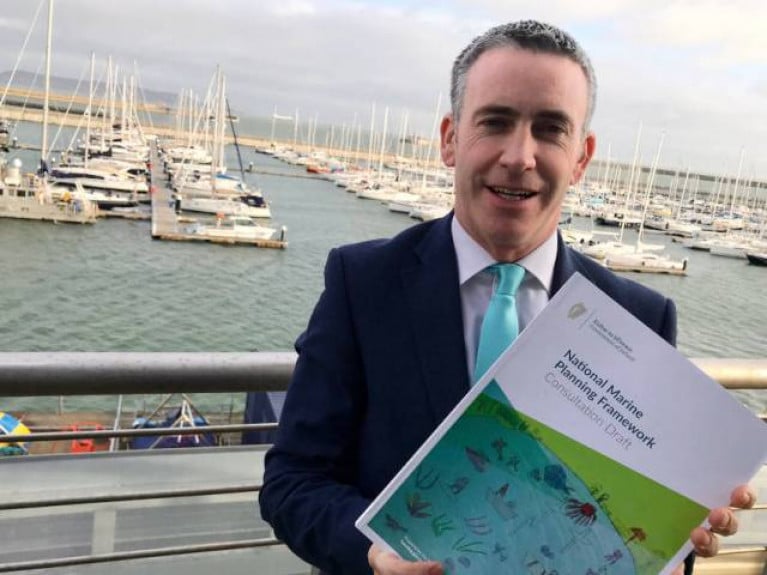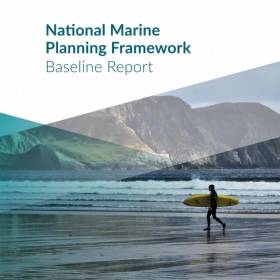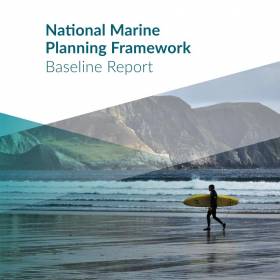Displaying items by tag: National Marine Planning Framework
Public Events On Draft National Marine Planning Framework Postponed
A number of public events scheduled for later this month and early February on the draft National Marine Planning Framework have been postponed.
Events had been due to take place in Killybegs on Monday 27 January, Wexford town on Thursday 30 January, Bantry on Monday 3 February and Kinsale on Thursday 6 February.
These dates will now be rescheduled between March and April, with locations and times to come.
The current schedule of pubic events on the draft framework resumes on Wednesday 12 February at the Arklow Bay Hotel from 6pm to 10pm.
In addition, the closing date for the receipt of submissions on the draft framework has been extended to Thursday 9 April at 3pm.
Submissions are still welcome and may be forwarded by email to [email protected] or in writing to: MSP Submissions, Marine Spatial Planning Section, Department of Housing, Planning, Community and Local Government, Newtown Road, Wexford Y35 AP90.
‘Critical That We Provide Framework’ For Marine Planning Says Minister At Launch Of Draft Consultation
Sixteen different sectors and activities are within the scope of the draft National Marine Planning Framework (NMPF) launched yesterday (Tuesday 12 November).
And plans for a system of designated Strategic Marine Activity Zones among its main ambitions, as previously reported on Afloat.ie.
Commenting on the draft, Damien English, Minister of State for Housing and Urban Development, said: “Our ocean supports a diverse range of economic activities such as seafood, tourism, renewable ocean energy and a wide range of recreational opportunities.
“It contains areas with some of the most productive and diverse resources in the world. Its ecosystem and biodiversity make it an environmental and social treasure.
“As our marine and coastal areas experience more pressures from human activity it is critical that we provide a framework for what activities should and shouldn’t happen in our marine and coastal areas.”
The minister notes that a component of the draft NMPF is its policies relating to renewable energy and action on climate change.
He said: “Climate change is the defining challenge of our generation. The Government’s Climate Action Plan, published in June, highlighted the critical role of marine planning for the delivery of offshore renewable energy. This document sets out the proposed forward-planning framework within which our renewable energy targets can be met.”
The Climate Action Plan commits to increasing the level of electricity generated from renewable sources to 70%, indicatively including at least 3.5GW of offshore renewable energy.
In addition, the draft NMPF reinforces the Government’s stated commitment to move away from oil combustion within heat and transport sectors towards renewables in the coming decade.
Minister English also launched the Government’s new Marine Planning Policy Statement, which was subject to public consultation this past summer and outlines the Government’s vision for the future development of the marine planning system.
It also sets out the overarching policies and principles the Government says it expects marine planning bodies, and other public bodies that engage with the marine planning system, to observe.
Just as the NMPF will be a parallel document to the National Planning Framework, the Marine Planning Policy Statement is a parallel document to the Planning Policy Statement, which underpins the operation of Ireland’s entire land-planning system.
The minister has invited the public and all interested parties to give their views on the draft framework.
“The document we’re publishing is the culmination of two years of engagement and dialogue with the public and stakeholders and across Government,” he said.
“The very constructive engagement with the NMPF Baseline Report, published last year, has had a major influence on this document. Whether you are in the energy sector, a fisherman, want to protect our marine environment, or live in a coastal community and are concerned about your area’s future, please have your say before February 28th.
“We want the finalised plan to be national in every sense — valued, owned and supported by all. Strong public input will help achieve that.”
The National Marine Planning Framework Consultation Draft is available to read or download HERE.
Draft National Marine Planning Framework To Be Published Tomorrow At Latest Stakeholder Advisory Meeting
The eighth and latest stakeholder advisory meeting on the National Marine Planning Framework takes place tomorrow, Tuesday 12 November, from 10am at the Commissioners of Irish Lights in Dun Laoghaire.
Tomorrow’s meeting will also see Damien English, Minister of State at the Department of Housing, Planning and Local Government, formally launch and publish the Draft National Marine Planning Framework for public consultation.
It’s expected that the marine environment will be a primary focus of the framework, following the public response to the baseline report announced earlier this year.
Marine Environment Raised By More Than Half Of Submissions On New Planning Framework
More than half of submissions (53%) in the public consultation on the National Marine Planning Framework Baseline Report concerned the marine environment.
Ports and shipping (44%), climate change (42%) and nature conservation (41%) were other important topics raised among the 173 submissions received by the Department of Housing, Planning and Local Government from a wide range of stakeholders.
Published late last year, the baseline report aimed to bring together a clear picture of all activity in Ireland’s seas for the first time.
As previously reported on Afloat.ie, representatives from all key sectors comprise an advisory group overseeing the process.
In its preliminary analysis of responses, the department also identified renewable energy, aquaculture and fisheries, seaweed harvesting, cultural heritage and assets, and consents and licensing as other areas of importance to a cohort of stakeholders that runs from public sector bodies to local authorities, coastal community groups and sports bodies.
One of the key questions asked of respondents regarded Ireland’s future approach to spatial designation marine planning, with the vast majority of the 57 who expressed a preference opting for either a policy-led plan (44%) or a hybrid of policy and zoning (40%).
The proposal for a National Marine Planning Framework has been broadly welcomed by respondents, with the Irish Marine Federation (IMF) describing it as “the most significant shift in Irish marine policy for several decades” while adding that the economic contribution of sport and recreational boating, including marine tourism, has thus far been largely underestimated, and related policy should be fully integrated in any plan.
The IMF also raised the question of spatial planning in relation to Brexit, with lack of resolution of boundary issues over the likes of Lough Foyle and Carlingford Lough “a matter of great concern”.
All responses to the public consultation have been collected HERE.
A Public, Policy-Led Plan With Climate Change Focus: What Ireland Wants From New Marine Spatial Plan
A policy-based plan that puts climate change front and centre and steers away from privatising coastal resources is what the country wants from the State’s National Marine Planning Framework, as The Irish Times reports.
Details have been released from the recently concluded consultation on the framework’s baseline report, released in September and branded as “a key part of the process of developing Ireland’s first marine spatial plan”.
The majority of responses (53%) were related to the marine environment, with 42% of submissions raising the prospect of the plan including measures to deal with climate change.
That news is timely with fears that coastal erosion poses a threat to hundreds of communities around Ireland.
Respondents also expressed preference for a policy-driven approach over specific zoning or a hybrid of the two, and many were adamant that the plan must retain Ireland’s marine resources in public hands.
The Irish Times has much more on the story HERE.
Galway Hosts Public Meeting On Marine Planning Framework
Sean Kyne, Minister of State with responsibility for rural affairs and natural resources, was speaking this morning (Friday 5 October) in Galway’s Town Hall Theatre, as Galway Bay FM reports.
The minister was attending one of a series of regional events for the public on the National Marine Planning Framework Baseline Report.
As previously reported on Afloat.ie, the recently published report sets out the context in which the marine equivalent of the National Planning Framework is being developed.
The public consultation will remain open till Friday 14 December.
According to the Connacht Tribune, activist group Galway Bay Against Salmon Cages was scheduled to hold a silent demonstration outside the theatre.
The group protests the inclusion of salmon farming multinational Marine Harvest on the framework’s stakeholder consultation panel.
Public Invited To Have Their Say On National Marine Planning Framework Report
#OurOceanWealth - A new report aims to brings together a clear picture of all activity in Ireland’s seas for the first time.
Published yesterday (Tuesday 18 September), the National Marine Planning Framework Baseline Report has been branded “a key part of the process of developing Ireland’s first marine spatial plan”, which is intended to be the marine equivalent of the National Planning Framework.
The report sets out the context in which the marine plan is being developed in order to identify the key issues to address via consultation or discussion with various stakeholders, whose responses will inform the first draft framework to be published in mid 2019.
Representatives from all key sectors — fisheries, aquaculture, energy, tourism, sport, local authorities and environmental NGOs — comprise an advisory group overseeing the process.
Speaking on the Baseline Report, Damien English, Minister of State at the Department of Housing, Planning and Local Government with responsibility for marine planning, said: “When we see the demands being placed on our marine area clearly laid out, we can effectively consider whether those demands can be met simultaneously or whether some management or governance is required in particular areas.
“As we move further along the process of plan-making, the report, and your feedback on it, will play a critical part in the examining of potential synergies and co-existences, facilitating conflict resolution, anticipating future spatial needs and balancing the ecological, economic and social elements of the marine in a sustainable fashion.”
Developed with assistance from the Marine Institute, the report is available online and the public are invited to make submissions on it until noon on Friday 14 December.
A series of regional panel events discussing the report will be held shortly in Waterford (Tuesday 2 October), Galway (Friday 5 October), Sligo (Friday 12 October), Cork (Friday 19 October) and Dublin (Tuesday 23 October).



































































